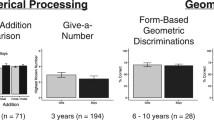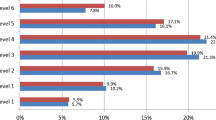Abstract
Gender differences in mathematical achievement have been examined in a wide range of age groups but only a few studies addressed this issue in preschool children. We compared preschool girls (n = 570) and boys (n = 524) from Germany with regard to numerical competencies. Differences in overall group means and the frequency of representation at low, middle, or high levels of performance were explored for girls and boys. Analysis of overall group means revealed that boys showed a better performance than girls (d = .32). The analysis of frequencies showed differences in both tails but not in the middle of the distribution of numerical competencies. While boys were more often found at higher levels of performance, girls were found to be overrepresented in the low-ability end of the distribution. These findings demonstrate that gender differences in mathematical achievement can emerge before school entry and stress the importance of further research looking for gender divides in mathematical achievement in preschool children from different countries as well as possible underlying factors.
Similar content being viewed by others
Notes
The study served as a screening study for the project “Neurobehavioral Development of Reading and Arithmetic Skills–A Longitudinal Study” (ReAL) that is part of the research activities of the “Center for Individual Development and Adaptive Education” (IDeA) located in Frankfurt am Main, Germany. http://www.idea-frankfurt.eu
In Germany, 7-year old children can still attend kindergarten because a school entry deferment is possible.
As revealed by chi-square tests, the frequency of girls and boys in the respective months did not significantly differ (October: number of girls = 74, number of boys = 57, χ 2 (1) = 1.15, p = .284; November: number of girls = 125, number of boys = 140, χ 2 (1) = 3.41, p = .065; December: number of girls = 117, number of boys = 93, χ 2 (1) = 1.36, p = .244; February: number of girls = 36, number of boys = 35, χ 2 (1) = .06, p = .807; March: number of girls = 64, number of boys = 66, χ 2 (1) = .49, p = .485; April: number of girls = 74, number of boys = 82, χ 2 (1) = 1.59, p = .208; May: number of girls = 14, number of boys = 10, χ 2 (1) = .38, p = .537) except for January (number of girls = 66, number of boys = 41, χ 2 (1) = 4.36, p = .037).
Analyses of frequencies for the quantity-number task were also conducted using the 10th and the 90th as well as the 20th and the 80th percentile, which did not change the results substantially (see Appendix 1).
References
Antell, S. E., & Keating, D. P. (1983). Perception of numerical invariance in neonates. Child Development, 54, 695–701.
Brehl, T., Wendt, H., & Bos, W. (2012). Geschlechtsspezifische Unterschiede in mathematischen und naturwissenschaftlichen Kompetenzen [Gender-specific differences in mathematical and science competencies]. In W. Bos, H. Wendt, O. Köller, & C. Selter (Eds.), TIMSS 2011: Mathematische und naturwissenschaftliche Kompetenzen von Grundschulkindern in Deutschland im internationalen Vergleich (pp. S. 203–S. 230). Münster: Waxmann.
Carr, M., & Jessup, D. L. (1997). Gender differences in first grade mathematics strategy use: Social and metacognitive influences. Journal of Educational Psychology, 98, 318–328.
Cvencek, D., Meltzoff, A. N., & Greenwald, A. G. (2011). Math-gender stereotypes in elementary school children. Child Development, 82, 766–779.
Esser, G. (2002). Basisdiagnostik für umschriebene Entwicklungsstörungen im Vorschulalter [Basic diagnostic for specific developmental disorders in preschool age] (BUEVA). Göttingen: Hogrefe.
Frey, A., Heinze, A., Mildner, D., Hochweber, J., & Asseburg, R. (2010). Mathematische Kompetenz von PISA 2003 bis PISA 2009 [Mathematical competence from PISA 2003 to PISA 2009]. In E. Klieme, C. Artelt, J. Hartig, N. Jude, O. Köller, M. Prenzel, W. Schneider, & P. Stanat (Eds.), PISA 2009. Bilanz nach einem Jahrzehnt (pp. S. 153–S. 176). Münster: Waxmann.
Geary, D. C. (1996). Sexual selection and sex differences in mathematical abilities. The Behavioral and Brain Sciences, 19, 229–284.
Guiso, L., Monte, F., Sapienza, P., & Zingales, L. (2008). Culture, gender, and math. Science, 320, 1164–1165.
Halpern, D. F. (1997). Sex differences in intelligence. Implications for education. American Psychologist, 52, 1091–1102.
Halpern, D. F., Benbow, C. P., Geary, D. C., Gur, R. C., Hyde, J. S., & Gernsbacher, M. A. (2007). The science of sex differences in science and mathematics. Psychological Science in the Public Interest, 8, 1–51.
Hyde, J. S., Fennema, E., & Lamon, S. J. (1990). Gender differences in mathematics performance: A meta-analysis. Psychological Bulletin, 107, 139–155.
Hyde, J. S., & Mertz, J. E. (2009). Gender, culture, and mathematics performance. Proceedings of the National Academy of Sciences of the United States of America, 106, 8801–8807.
Krajewski, K., & Schneider, W. (2009). Early development of quantity to number-word linkage as a precursor of mathematical school achievement and mathematical difficulties: Findings from a 4-year longitudinal study. Learning and Instruction, 19, 513–526.
Lindberg, S. M., Hyde, J. S., Petersen, J. L., & Linn, M. C. (2010). New trends in gender and mathematics performance: A meta-analysis. Psychological Bulletin, 136, 1123–1135.
Michalczyk, K., Malstädt, N., Worgt, M., Könen, T., & Hasselhorn, M. (2012). Age differences and measurement invariance of working memory in 5-to 12-year-old children. European Journal of Psychological Assessment. doi:10.1027/1015-5759/a000149.
Pauly, H., Linkersdörfer, J., Lindberg, S., Woerner, W., Hasselhorn, M., & Lonnemann, J. (2011). Domain-specific rapid automatized naming deficits in children at risk for learning disabilities. Journal of Neurolinguistics, 24, 602–610.
Pawelec, B., & Kurz-Milcke, E. (2009). Gender differences in early mathematics strategy use. In Proceedings of the XIV European Conference of the ESDM.
Penner, A. M., & Paret, M. (2008). Gender differences in mathematics achievement: Exploring the early grades and the extremes. Social Science Research, 37, 239–253.
Shaywitz, B. A., Shaywitz, S. E., Liberman, I. Y., Fletcher, J. M., Shankweiler, D. P., Duncan, J., et al. (1991). Neurolinguistic and biological mechanisms in dyslexia. In D. D. Duane & D. B. Gray (Eds.), The reading brain: The biological basis of dyslexia (pp. 27–52). Parkton, MD: York Press.
Starkey, P. (1992). The early development of numerical reasoning. Cognition, 43, 93–126.
Starkey, P., Spelke, E. S., & Gelman, R. (1990). Numerical abstraction by human infants. Cognition, 36, 97–127.
Steele, C. M., & Aronson, J. (1995). Stereotype threat and the intellectual test performance of African Americans. Journal of Personality and Social Psychology, 69, 797–811.
Wilson, A., & Dehaene, S. (2007). Number sense and developmental dyscalculia. In D. Coch, G. Dawson, & K. Fischer (Eds.), Human behavior, learning, and the developing brain: Atypical development (pp. 212–238). New York: Guilford Press.
Acknowledgments
This research was funded by the Hessian initiative for the development of scientific and economic excellence (LOEWE). We would like to thank all the participating children.
Author information
Authors and Affiliations
Corresponding author
Appendices
Appendix 1
Appendix 2
Rights and permissions
About this article
Cite this article
Lonnemann, J., Linkersdörfer, J., Hasselhorn, M. et al. Gender differences in both tails of the distribution of numerical competencies in preschool children. Educ Stud Math 84, 201–208 (2013). https://doi.org/10.1007/s10649-013-9488-0
Published:
Issue Date:
DOI: https://doi.org/10.1007/s10649-013-9488-0




